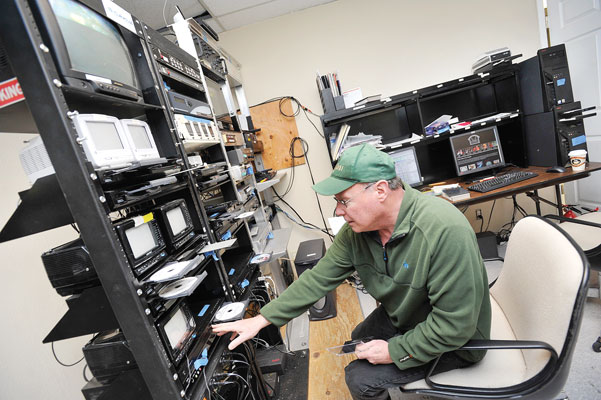If it’s shot locally, then there’s a place for it on TV
– that is via Morgan Hill Access TV. Though it’s not well known,
nor does it have a huge budget, Morgan Hill Access TV has given a
home to hours of locally made content for more than 10 years. Got
video from a hike? What about Grandma’s 100th birthday? Ever
dreamed of starting your own talk show?
Morgan Hill Access TV will assist any resident with this dream
and even provide all the needed equipment, including a studio to
shoot in, free of charge.
If it’s shot locally, then there’s a place for it on TV – that is via Morgan Hill Access TV. Though it’s not well known, nor does it have a huge budget, Morgan Hill Access TV has given a home to hours of locally made content for more than 10 years. Got video from a hike? What about Grandma’s 100th birthday? Ever dreamed of starting your own talk show? Morgan Hill Access TV will assist any resident with this dream and even provide all the needed equipment, including a studio to shoot in, free of charge.
While a modest operation, Morgan Hill Access TV has grown by leaps and bounds in the past decade. Initially operating out of a trailer, they now have a fully functioning studio with a control room and green screen technology. The station runs wall to wall content every day on cable Channel 19 and is completely volunteer run. While the content is varied, local content is always given priority. Currently 24 hours of their weekly schedule is locally made programs, but they are hoping to increase that.
“We like to focus on local programming: Your neighbors, what’s going on locally. That’s what we do best,” said Bob Snow, a 48-year old graphic designer and MHAT board member.
There is always coverage of local events, including the Mushroom Mardi Gras, the Taste of Morgan Hill, the Fourth of July parade, the No Bull BBQ Cookoff and the Safe Night Halloween downtown. MHAT volunteers have also filmed political forums, public discussions and a host of other local events, both big and small.
Of all the public access stations in the Bay Area, MHAT is one of only two that are entirely volunteer run. The other is in Pacifica. MHAT’s budget for equipment, maintenance and rent was $24,000. This year’s projected budget is $27,000. This means that even positions with a fair amount of responsibility do not receive monetary compensation, people like MHAT Program Director Larry Talbot.
Before Talbot became the program director for MHAT, he worked for IBM as an IT architect. When he retired in 2004, he was looking for a way to fill his free time, which led him to MHAT.
“I picked this up initially as a hobby. Then I got interested in all aspects. They needed a program director, so I got involved with that,” said Talbot, 62.
Every Wednesday, Talbot sets up the upcoming week’s schedule. Over the years he’s worked to create a more efficient, technologically advanced control room. His programming background came in handy when he decided to create a program for MHAT that would help to automate streaming video sources from the Internet even when nobody was in the studio.
When preparing the week’s schedule, the top priority, according to Talbot is local programming. “If you want to say something to the rest of Morgan Hill, come on in so the residents can see,” Talbot said.
After he’s filled every spot he can with local content, he schedules regional shows and alternative content, stuff not available on other cable stations, for instance streaming video from NASA and Free Speech TV.
A year after volunteering with MHAT, he was hired by the City of Morgan Hill as their government access technician, meaning he is responsible for the video content for Channel 17 which broadcasts the city’s meetings. He also now does consultant work for video productions.
“It’s kind of opened a new career for me,” he said.
Local stories abound
Before moving to a studio at their current facilities at 82 E. Second St., MACCC ran the station from a trailer in the Friendly Inn parking lot. While they’ve now been at their current location for more than seven years, they only recently expanded their facilities to include an entire front room. New technology such as green screen are an added bonus. With this expansion they hope to attract more volunteers.
One volunteer who got involved three years ago is Emma Harris, who started by helping film local events, but discovered a deeper sense of fulfillment when she created her own piece entitled, “War Veterans: A remembrance.”
She realized she had an interest in video production after taking classes at Gavilan College.
“I was working on a project for my business. I found out that I was good at it and liked it,” said Harris, 55.
While Harris always appreciated the sacrifices that men and women who serve in the military make, she learned a lot more about what the experience was like for them after interviewing them for her piece. She gathered six veterans and asked them a series of questions about their experiences during and after wartime.
Creating a TV show of her own was a new experience. She didn’t know what to expect.
“I had 20 questions prepared. We got three questions in and time would not allow for more,” Harris said. Despite no prior experience for assembling a television production of this caliber, everything came together well. She plans to make a second piece sometime before the 4th of July.
The piece ran six times and the response from the community was positive.
“I had a lot of veterans that saw it and liked it. I’ve ran into other veterans, not just locally, and they are grateful that someone gave them an opportunity to air their life,” Harris said.
For people who have never filmed and edited a TV show before, all that video equipment might seem a bit intimidating. But board member Marty Cheek encourages people to give it a try.
“I tell people it’s easier to use than a cell phone. They don’t believe me, but it’s true,” Cheek said.
Though Cheek joined the board in 2009, he has already contributed his fair share of content. Cheek, a 44-year-old freelance writer, co-wrote “Clean Energy Nation” with Congressman Jerry McNerney. Before joining MHAT’s board, he had very little experience producing video content. He’s quickly become an old pro.
Cheek likes filming local events and sees them as important documents. “I see the shows we produce as home movies for the community which will be great archives 20 years from now,” Cheek said.
Forum for public issues
Some of Cheek’s contributions have been more serious. In 2010, when controversy arose after four students were sent home at Live Oak High School for wearing American-themed clothing on Cinco de Mayo, Cheek organized and filmed a forum discussion between Mayor Steve Tate and Live Oak Superintendent Wes Smith. Cheek felt the public forum helped to soothe tensions.
“There was so much anger and anxiety that people weren’t really listening to each other. It seemed to calm people down when they heard the story behind it. That showed the effectiveness for public access as a forum for public issues,” Cheek said.
According to Cheek, it’s good that people have the ability to express their opinions in a public forum.
“It’s part of our First Amendment free speech rights. Even if I don’t agree with what people have to say, I support their ability to put it on air,” Cheek said.
Some residents that have gone on air are starting to get recognized around town. For Judy Keyes, what started out as a little recognition has evolved into something bigger. There are now a growing number of stations that air her MHAT production, “Cooking for all seasons.”
“I met Larry (Talbot) in 2004 and asked if he wanted to help me produce a show. Larry started shooting the show along with Bob Snow. Ever since they’ve been my supporters,” Keyes said.
Keyes, 60, is a retired programmer for United Technology. Cooking has always been a passion for her. Now, the opportunity to teach other people about her passion is a dream come true.
“I like to get people into the kitchen and try something, go into a store they’re not used to going in to, be a little adventurous,” Keyes said.
Cooking for all Seasons is one of the more popular programs on MHAT. Her show now plays in Salinas, Monterey, San Jose and several stations in Fresno County. She currently has her eyes set on more stations as well.
MHAT hopes that with the recent expansion of facilities they will attract more volunteers. People don’t have to create an entire show if they want to contribute content. There’s room for videos of all lengths.
“We get a lot of shorts for in-between programs. People will take a bunch of pictures of Henry Coe or something and set it to music. We are glad to show these,” said Talbot.
The all-volunteer board of directors believes so much in the importance of MHAT, that a lot of the expansion was paid for out of their own pockets. They did it to encourage more of the community to volunteer. They feel it was a good investment for Morgan Hill.
“Over the years, we’ve had hard times and we’ve had good times. Our future looks good so far,” 61-year-old board member Bill Leaman.
OPEN HOUSE
Stop by the office, 82. E. Second Street, April 26 from 5 to 8 p.m. and learn how to get involved. For more information call Larry Talbot, 782-8086 or email in**@**at.tv.








